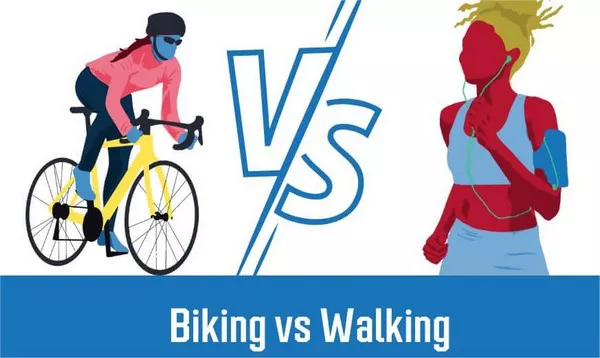In the realm of cardiovascular fitness, the debate between walking and cycling often arises: which activity reigns supreme for promoting heart health? Both walking and cycling are low-impact exercises that offer a plethora of benefits for overall well-being, including improved cardiovascular function, weight management, and mental health. However, when it comes to optimizing heart health, nuances exist that differentiate these two modes of exercise. To discern which is better for the heart, it’s essential to delve into the physiological mechanisms underlying each activity, explore their respective benefits, and consider individual factors that may influence effectiveness.
The Physiology Behind Walking and Cycling
At its core, heart health hinges on the ability of the cardiovascular system to efficiently deliver oxygen-rich blood to the body’s tissues. Both walking and cycling engage large muscle groups, stimulating the heart to pump blood more vigorously. However, the intensity and duration of exercise play significant roles in determining the extent of cardiovascular benefits.
Walking, a weight-bearing exercise, involves rhythmic movements of the lower body while supporting one’s own body weight. This moderate-intensity activity primarily targets the leg muscles and elevates heart rate to a moderate level. While walking is accessible to individuals of all fitness levels and ages, its cardiovascular benefits may be more pronounced with longer durations or brisker paces.
On the other hand, cycling, whether on a stationary bike or outdoors, provides a non-weight-bearing form of exercise. Pedaling engages the quadriceps, hamstrings, and glutes, generating substantial muscular effort. Depending on the terrain, speed, and resistance settings, cycling can range from low to high intensity, allowing for versatile cardiovascular training. High-intensity cycling, such as interval training or hill climbs, can elicit significant cardiovascular adaptations, including improved aerobic capacity and enhanced heart muscle strength.
The Benefits Unveiled: Walking and Cycling for Heart Health
Both walking and cycling confer myriad benefits for heart health, albeit through slightly different mechanisms. Let’s explore how each activity contributes to cardiovascular fitness:
1. Improved Heart Function: Engaging in regular physical activity, whether through walking or cycling, strengthens the heart muscle. As the heart pumps blood more efficiently, resting heart rate tends to decrease, reducing the workload on the heart and lowering blood pressure. This adaptation is crucial for long-term heart health and reducing the risk of cardiovascular diseases such as hypertension and coronary artery disease.
2. Enhanced Circulation: Both walking and cycling stimulate blood flow throughout the body, promoting better circulation. This increased blood flow delivers oxygen and nutrients to the muscles and organs while aiding in the removal of waste products. Improved circulation supports vascular health, reducing the risk of blood clots and peripheral artery disease.
3. Lowered Cholesterol Levels: Regular physical activity, including walking and cycling, can raise HDL (good) cholesterol levels and lower LDL (bad) cholesterol levels. By improving the lipid profile, these activities help prevent the buildup of plaque in the arteries, reducing the risk of atherosclerosis and heart disease.
4. Weight Management: Maintaining a healthy weight is paramount for heart health, and both walking and cycling contribute to calorie expenditure and weight management. While the calorie burn may vary depending on factors such as intensity and duration, engaging in either activity regularly can aid in weight loss or weight maintenance, reducing the risk of obesity-related heart conditions.
5. Stress Reduction: Physical activity has been shown to alleviate stress and improve mental well-being. Whether it’s a leisurely walk in nature or an invigorating bike ride, the rhythmic movements and release of endorphins during exercise can help combat stress and anxiety, which are known risk factors for heart disease.
Individual Considerations: Tailoring Exercise to Personal Needs
While both walking and cycling offer substantial benefits for heart health, individual preferences, fitness levels, and health conditions should be taken into account when choosing the optimal exercise regimen. Some factors to consider include:
1. Joint Health: Walking is generally gentler on the joints compared to cycling, making it a preferable option for individuals with arthritis or joint pain. However, proper bike fit and technique can minimize joint strain while cycling.
2. Accessibility: Walking requires minimal equipment and can be done almost anywhere, making it highly accessible. Cycling, while also versatile, may require a bicycle and access to safe riding routes.
3. Time and Intensity: The time commitment and intensity level of exercise may vary between walking and cycling. Individuals with limited time may find it easier to incorporate brisk walking into their daily routine, while cycling enthusiasts may prefer longer rides or interval training sessions.
4. Health Status: Individuals with pre-existing health conditions should consult with a healthcare professional before starting a new exercise regimen. Conditions such as heart disease, diabetes, or respiratory disorders may require modifications to exercise intensity or supervision during physical activity.
Conclusion
In the ongoing debate of walking versus cycling for heart health, both activities offer invaluable benefits that contribute to overall cardiovascular fitness. Whether one chooses to lace up their walking shoes or hop on a bicycle, the key lies in regularity, consistency, and enjoyment. By incorporating either or both of these activities into a balanced exercise routine, individuals can reap the rewards of improved heart function, enhanced circulation, and reduced risk of cardiovascular disease. Ultimately, the best exercise is the one that aligns with personal preferences, goals, and health considerations, paving the way for a healthier heart and a more vibrant life.

